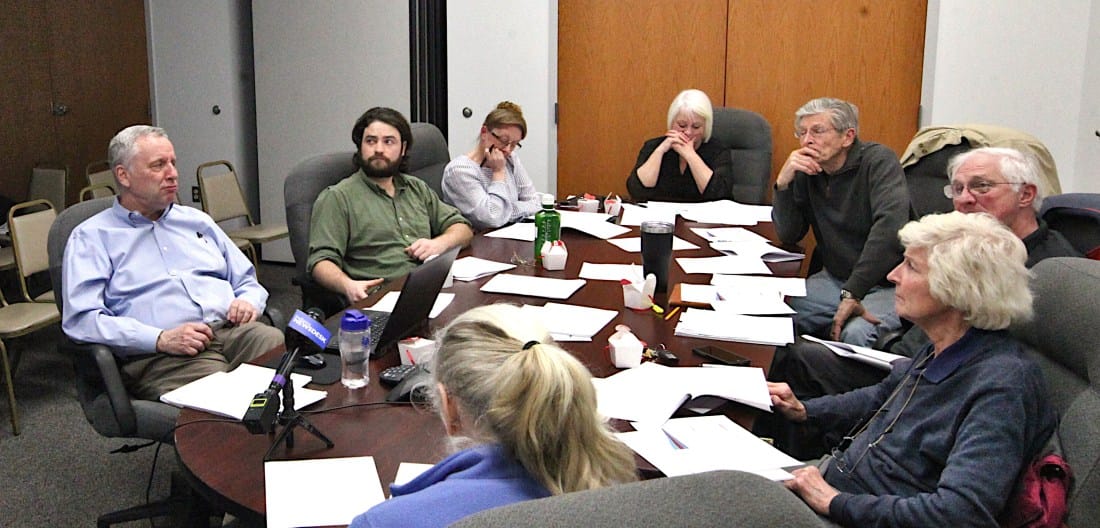Transit board tees up March 17 vote on new routes for fall, including one that could go outside Bloomington


On Tuesday night at its regular monthly meeting, Bloomington Transit’s board got a briefing from general manager Lew May on recommended staff adjustments to proposed new routes.
The board is expected to take a vote on the changes at its March 17 board meeting. The changes are planned to be implemented in August this year.
Compared to the first round of adjustments to a set of study-recommended route configurations, which were presented at January’s board meeting, a few of the routes saw no further changes.
But one set of proposed new routes is now proposed to be scrapped in favor of the existing configuration. The existing Route 6 and 6L run from Gourley Pike and Rogers, through IU campus and out to 3rd Street and SR 446. They were proposed to be replaced on the western side with a bi-directional loop (Route 60) circulating around downtown and campus and a linear route (Route 16) connecting out eastward to SR 446.
But at Tuesday’s board meeting, May said that staff now recommends to scrap the proposed Route 60 and Route 16 combination in favor of the existing Routes 6 and 6L. The existing routes have the highest ridership in the whole system, May said—they carry between 6,000 and 7,000 riders a day.
Indiana University is funding extensions to the 6 and 6L this year—to ensure that transit for residents who’ve been relocated to off-campus apartments when they were displaced from mold-plagued dormitories. Those route extensions are planned to stay in place, May said.
Still hanging in the balance after Tuesday’s board meeting is a board recommendation on the proposed Route 3 from downtown west on 3rd Street and southward on Curry Pike. Should Route 3 include service to Ivy Tech and Cook Medical? The question is controversial, because those education and employment centers are outside Bloomington city limits.
For BT to offer service to Ivy Tech and Cook Medical, would require a change to Bloomington’s local law that defines BT’s geographic area as “coterminous with the boundaries of the city of Bloomington.”
Implementing a potential BT board approval to extend service to Ivy Tech and Cook Medical would depend on a city council decision to change the local ordinance defining BT’s service area. Bloomington’s city councilmembers have not discussed the question at any of its public meetings this year.
The Greater Bloomington Chamber of Commerce has advocated for the BT service area boundary change this year—at meetings of the BT board and the city council.
At Tuesday’s BT board meeting, James McLary, who joined the meeting by phone, stated support for the idea of providing service to Ivy Tech and Cook Medical outside the city limits.
Board member Marilyn Hartman said she did not support the change to BT’s service area at this time. That’s because bus service is already being provided from inside Bloomington to Ivy Tech and Cook Medical—by Rural Transit. BT runs buses on a Route from downtown to a stop at Whitehall Crossing shopping center. Riders can transfer at Whitehall Crossing to a Rural Transit bus for the rest of the trip to Ivy Tech and Cook Medical.
Even if the city council were supportive of the necessary ordinance change, Hartman said, she does not understand how the funding would work—she doesn’t see the county council stepping up with any additional funding.
At Tuesday’s meeting, May said the staff is neutral on the question of service outside the city limits. It will be up to the five-member BT board to vote on the question at its March 17 meeting. Any decision on the ordinance change depends on the city council.
Another still open question is the exact configuration and scheduling of Routes 4 and 14, which have several apartment complexes located along them. May said BT had reached out to the owners of those complexes about the possibility that they might help fund additional public service, instead of running their own private shuttles.
May reported there was some interest expressed by some of the apartment complex owners. Board member Kent McDaniel said he would be shocked if the apartment complex owners were able to strike a deal in the next month.
Other routes saw some additional minor tweaks at Tuesday’s board meeting. The initial round of adjustments backed off somewhat from the study recommendations to end evening service early on routes where evening ridership is low. In many instances, the staff adjustments don’t restore the span of hours to that of current routes, but do add an extra couple of hours compared to the initial proposal.
BT is still considering using an outsourced micro-transit service to make up for the earlier end to evening service on many routes. Micro-transit is an Uber/Lyft style on-demand, app-based service where a vehicle might pick up additional people after heading to a passenger’s designation.
The funding for micro-transit is hoped to come from a Federal Transit Administration grant for which BT has applied. May said on Tuesday that news on the grant is expected in March. If the funding does not come through, there are a few different options, May said. One is to apply for the next round of FTA grant funding. A second option is to use BT cash reserves.
A third possibility is to use local income tax revenues from an increase that the city council might enact. Since New Year’s Day, when Bloomington’s mayor, John Hamilton, suggested that the city council should add an additional 0.5 points to the countywide income tax, the council has not put the topic on any of its public meeting agendas.




Comments ()